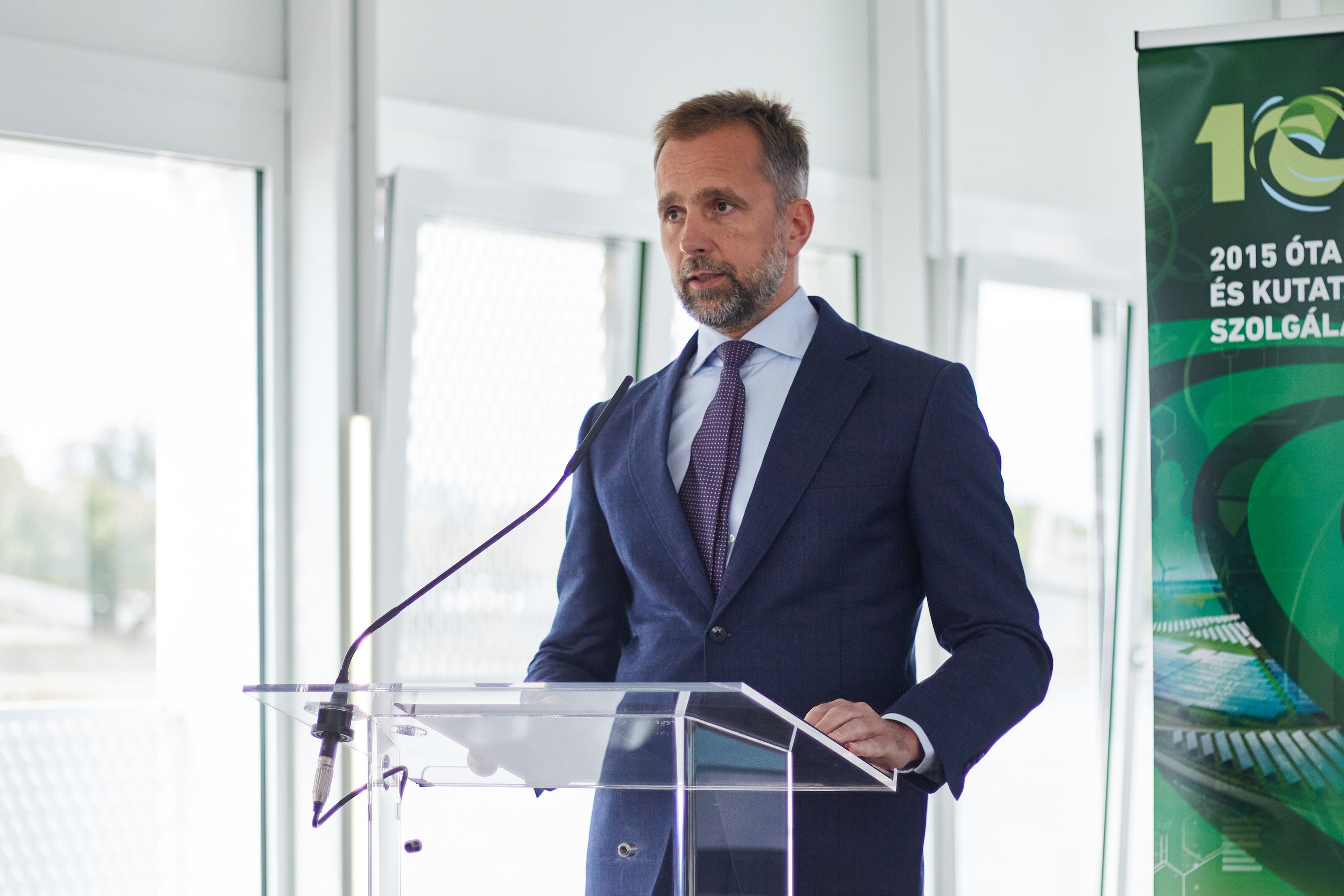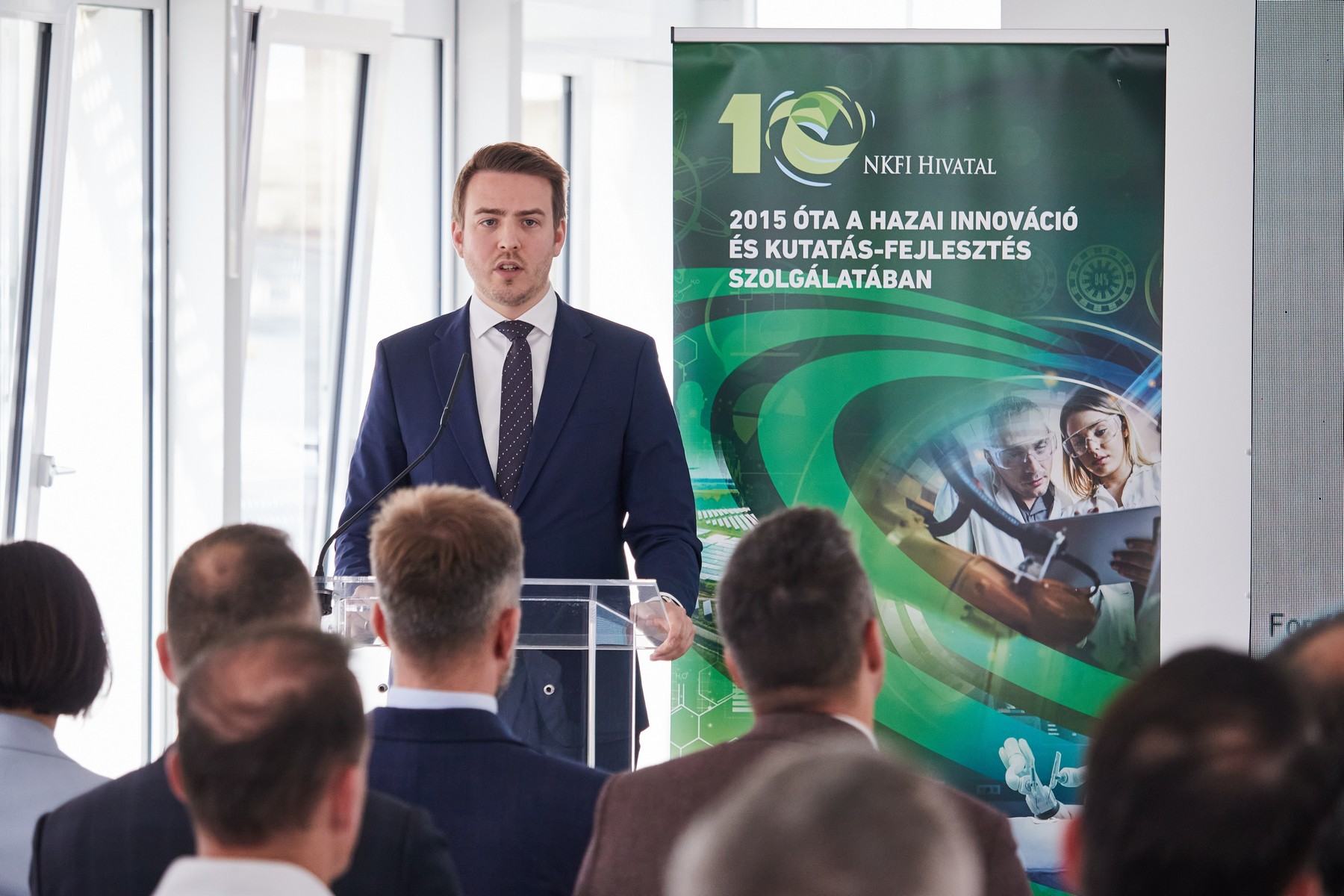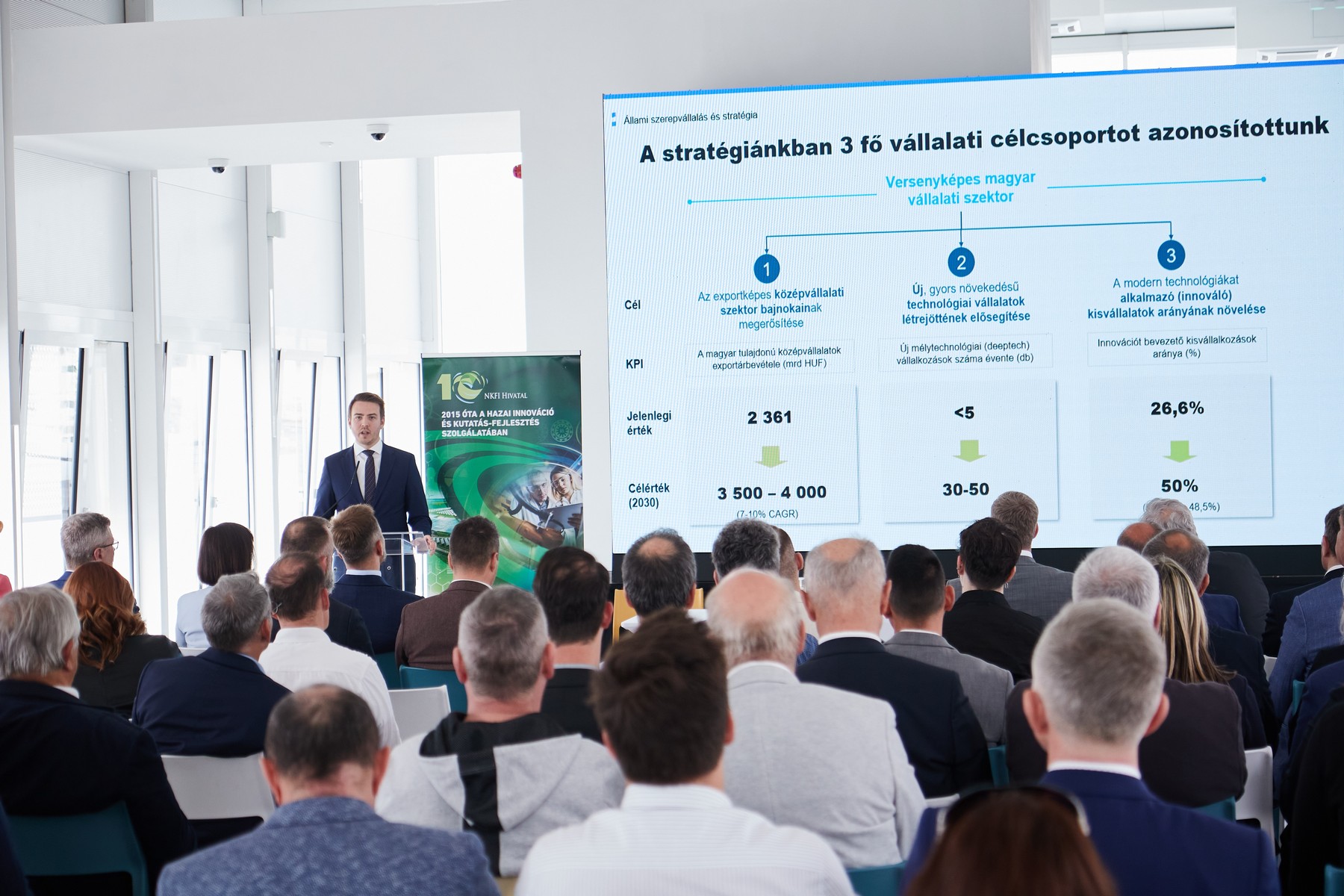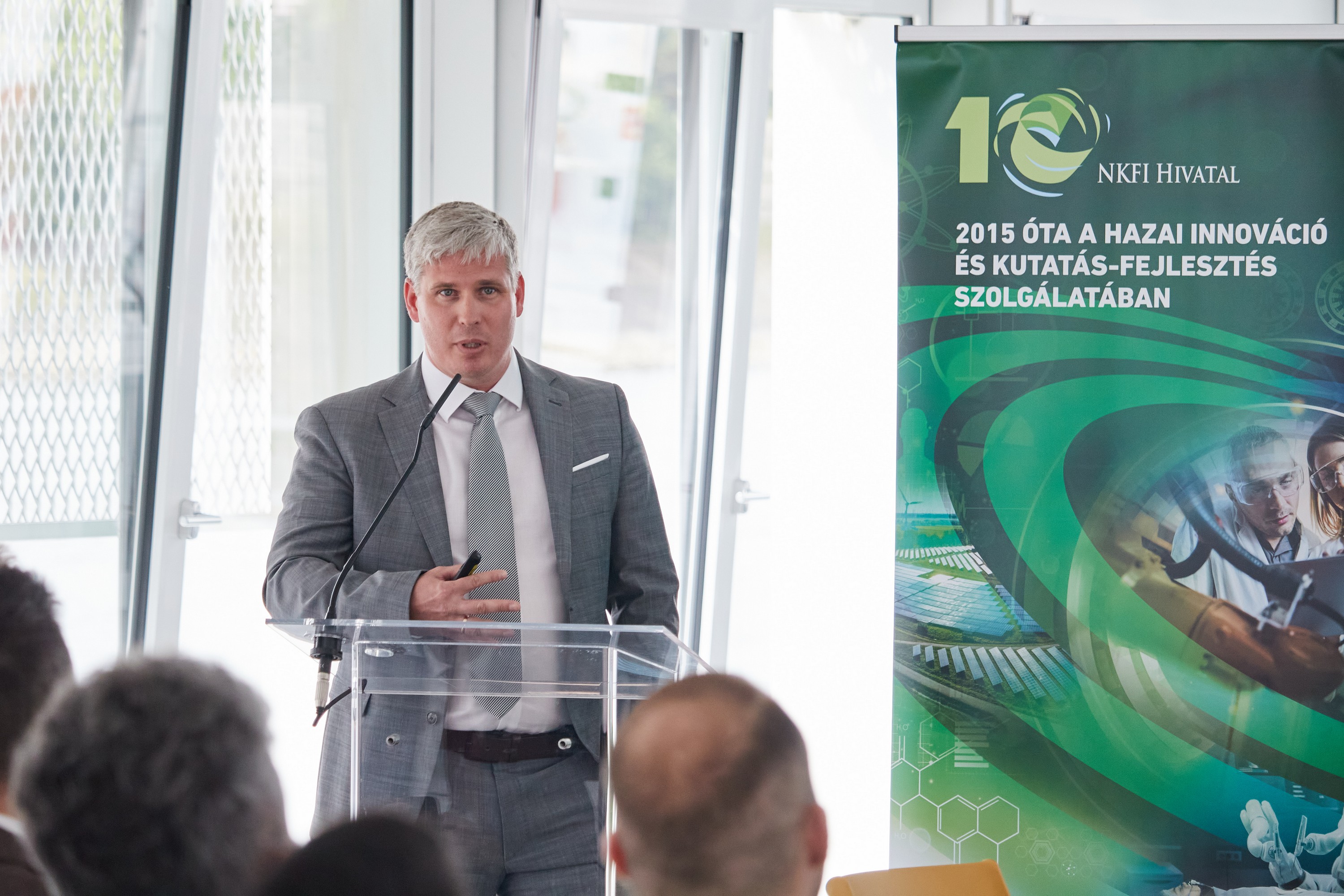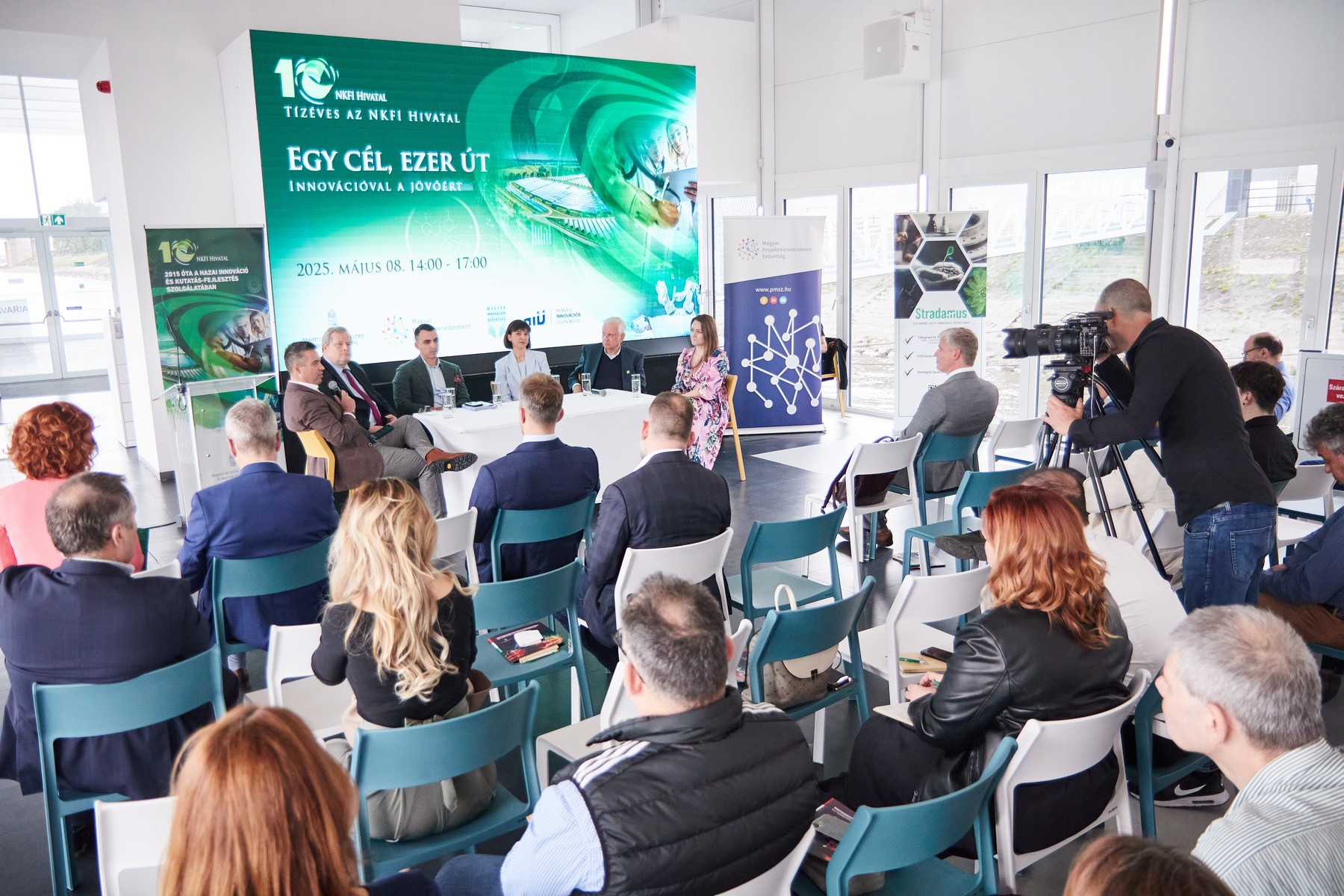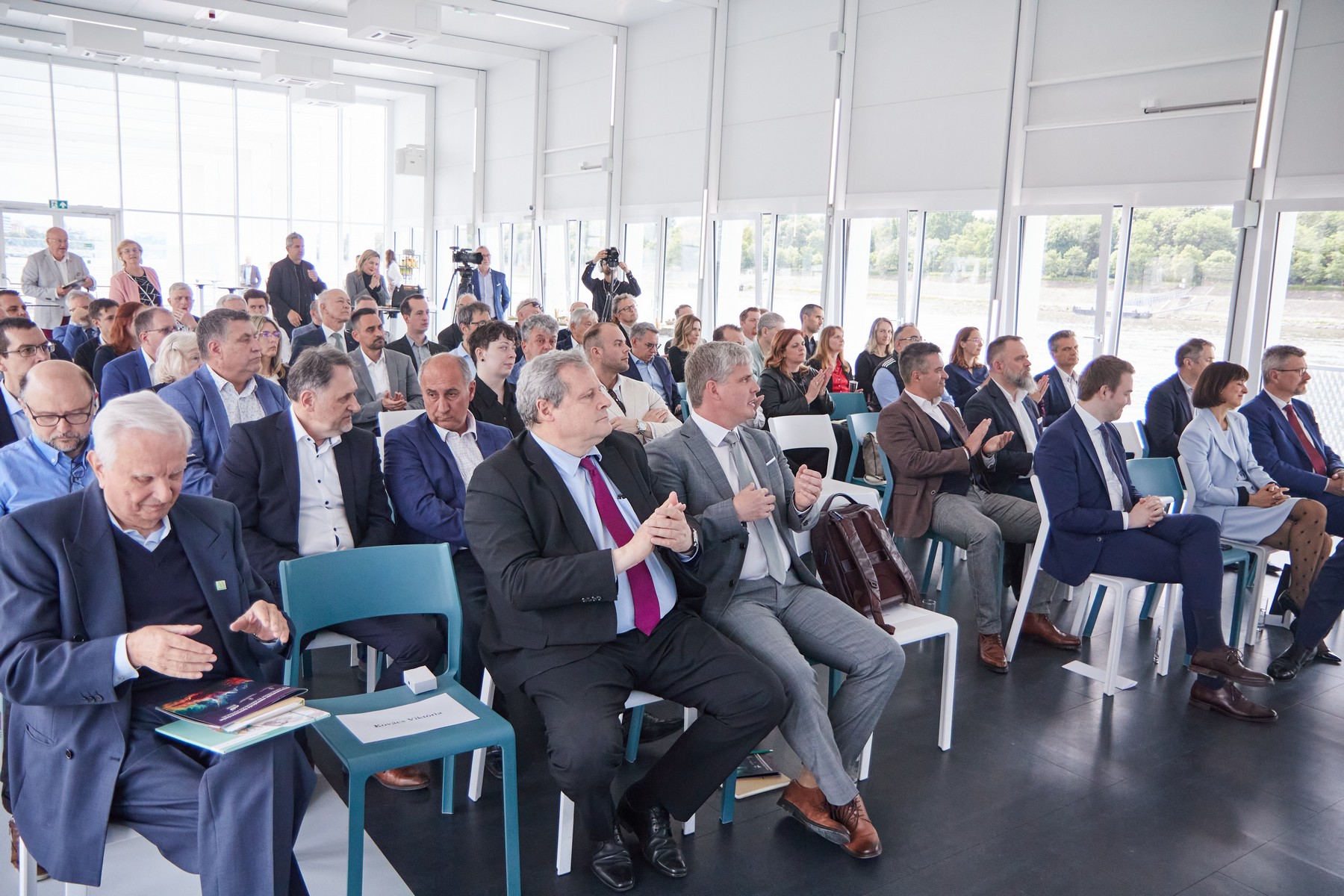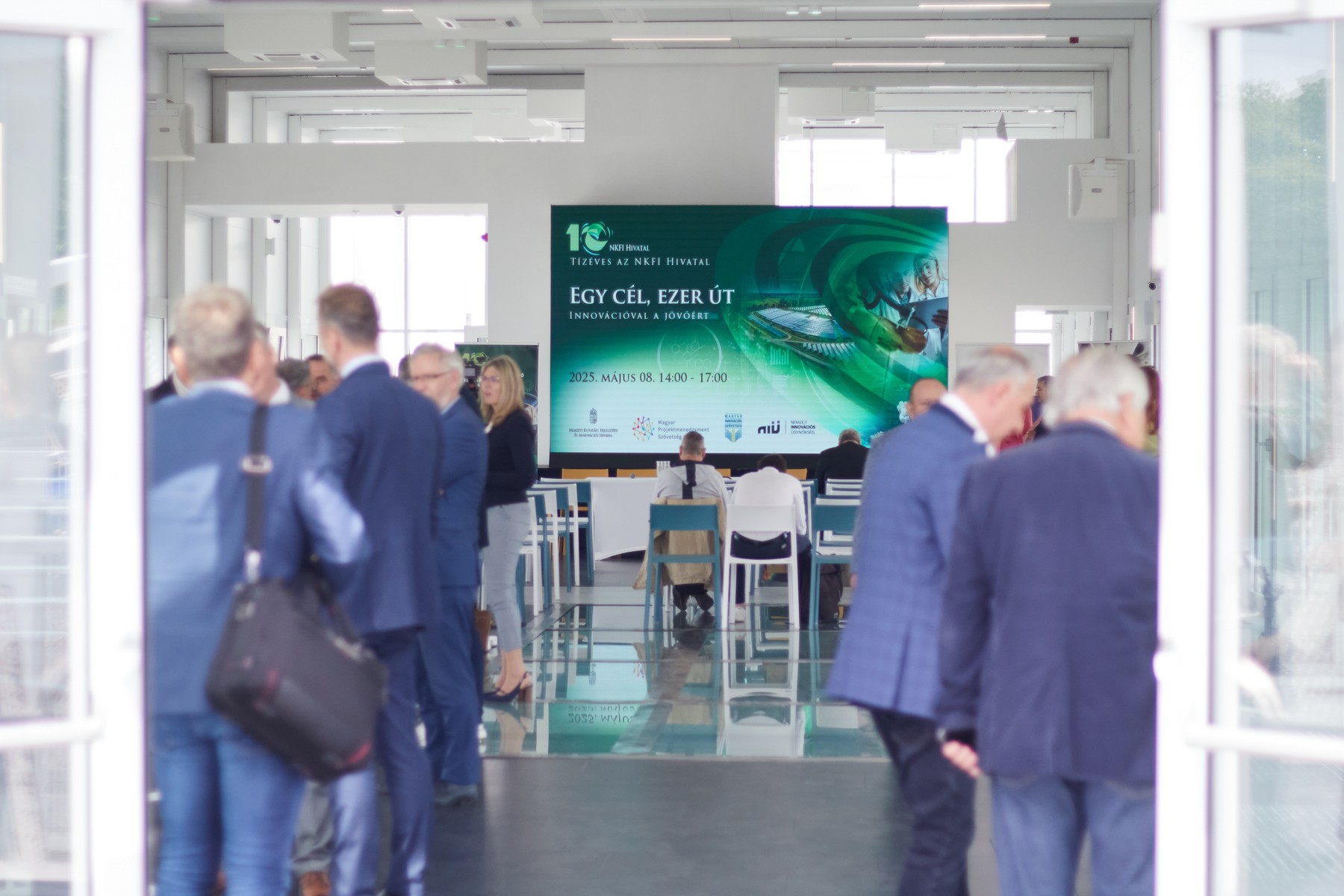The National Research, Development and Innovation Office (NRDI Office) is celebrating its 10th anniversary this year. On this occasion, the office, in close cooperation with the Hungarian Project Management Association, is organising a four-part conference series to review the results of corporate innovation, the market introduction of scientific outcomes, new paths for innovation financing, and the effective exploitation of synergies in the innovation ecosystem. The first event, which focused on successful businesses in innovation – thanks, among other things, to the support from the NRDI Office – was recently held in Budapest.
The National Research, Development and Innovation Office (NRDI Office) was established a decade ago, in 2015. To celebrate this milestone, it is hosting a large-scale conference series comprising four events. The aim of the event series is not only to honour the achievements of the past decade but also to explore the innovation opportunities of the coming decade by uniting key actors of the Hungarian research, development and innovation (RDI) ecosystem. The first event focused on strengthening the innovation potential of businesses, showcasing how the support of the NRDI Office helped Hungarian companies develop more competitive technologies and products, and contributed to job creation. The conference was organised by the NRDI Office in close cooperation with the Hungarian Project Management Association (PMSZ), with additional professional partners including the Hungarian Association for Innovation, the Hungarian Innovation Agency and Stradamus Zrt.
The venue of the event, the Stopper Floating House on the banks of the Danube in Budapest, provided an impressive setting where modernity and tradition met in perfect harmony. The stunning view of the flowing river and the city – with a mix of old and ultra-modern buildings and the silhouette of the House of Parliament in the distance – offered a nearly symbolic backdrop to the conference’s motto: One goal, a thousand paths – innovation for the future.
For many, innovation means the spark of a new invention, but the speakers and participants of the event proved that innovation is much more: the shared result of strategy, perseverance, collaboration and market-driven thinking – but let’s not get ahead of ourselves. The conference was opened by Ádám István Kiss, President of the NRDI Office, in charge of the organisation since 2023. He firmly believes that the path of innovation is the only true opportunity for growth in the Hungarian economy. Innovation – contrary to common interpretations – is not just about major technological breakthroughs, but also about enhancing business competitiveness and generating significant economic, social and intellectual impact. In his speech, he highlighted the catalytic role of the NRDI Office, thanks to which nearly 3000 businesses and over 4400 scientific projects received more than HUF 700 billion in funding over the past decade, and more than 13,000 university students, PhD candidates and young researchers benefited from scholarships. In addition to funding, he considers mindset-shaping and conscious ecosystem-building equally important, which is carried out in close cooperation with the Ministry of Culture and Innovation and the Hungarian Innovation Agency. Their goal is to support the creation of marketable products or services from research results and business ideas by all possible means. “Innovation is successful when research and the market go hand in hand,” he said, emphasising the importance of a market-oriented approach.
An innovation-driven economy improves productivity
László Bódis, Deputy State Secretary for Innovation at the Ministry of Culture and Innovation, presented the strategy for innovation-driven growth in the Hungarian economy. In his presentation, he summarised the key findings of a comprehensive professional analysis published in the March issue of Hitelintézeti Szemle, which addresses the state of the Hungarian innovation ecosystem, its challenges and the responses to those challenges. As he explained, economic growth between 2010 and 2015 was primarily driven by a dynamic expansion of employment, which – through the actual creation of one million new jobs promised by the government one and a half decades earlier – led to significant GDP growth. In the subsequent period, between 2015 and 2019, two-thirds of GDP growth was already attributable to productivity gains, driven mainly by innovation. “Innovation should not be seen merely as the emergence of an occasional new invention. In the modern sense, innovation also includes the renewal of manufacturing technologies, organisational structures, services and processes.”
The Deputy State Secretary highlighted that Hungary currently ranks around 20th on the European Innovation Scoreboard, but the goal is to reach the top third, which would mean achieving 10th place. To this end, it is crucial to increase R&D expenditure as a share of GDP from the current 1.4% to 3%. This requires stronger involvement from the business sector, as was also discussed later during the event. In developed countries, two-thirds of R&D spending is financed by the business sector, while in Hungary the ratio is the reverse. Bódis cited the successful innovation models of Singapore, South Korea and Israel as examples, where the state acts as a catalyst, while education, knowledge-sharing and the regulatory environment also play key roles. “Innovation is not just about money, but the result of cooperation and a long-term strategy,” he concluded.
Significant successes in the pharmaceutical industry
Dr. István Greiner, Research and Development Director at Richter Gedeon Nyrt., presented one of the greatest success stories in the Hungarian pharmaceutical industry. Richter allocates over EUR 200 million annually – nearly HUF 80 billion – to R&D, which accounts for roughly 10% of the company’s yearly revenue. Employing nearly 12,000 people worldwide, the company has a team of 1200 researchers, and its product portfolio currently includes 150 different formulations. Greiner emphasised that the development of an original pharmaceutical product takes 12 to 15 years and nowadays requires an investment of around EUR 2 billion. Despite the substantial time and cost, only about 8% of these costly and prolonged development efforts result in a marketable product. “Pharmaceutical research is like a long, risky expedition: it requires enormous amounts of resources, and only a few reach the destination,” he explained.
One of Richter’s most significant recent scientific and commercial achievements is the active ingredient Cariprazine, developed in collaboration with the US-based AbbVie. This innovative antipsychotic, on the market since 2015, has already been used by approximately 1.7 million patients worldwide and last year alone generated USD 3.3 billion in revenue for the companies involved. Greiner stressed that the success of Richter was also greatly supported by significant contributions from the NRDI Office and the Government. Over the past decade, Richter received a total of HUF 16.9 billion in funding, which supported the implementation of dozens of successful R&D projects, including groundbreaking pharmaceutical developments, for which the company invested HUF 44 billion in total. The company closely cooperates with prestigious Hungarian higher education institutions such as the Budapest University of Technology and Economics, ELTE and the University of Pécs, further strengthening the creation of high value-added health industry innovations based on domestic expertise.
Engineering precision and the global market
Gábor Kiglics, Managing Director of eCon Engineering Kft., used the example of a 110-person independent engineering firm to illustrate how Hungarian expertise can also be successfully leveraged on global markets. The company specialises in virtual product development, finite element simulation solutions and the design of manufacturing automation systems and equipment. These high value-added technical collaborations have enabled the company to establish a significant presence in sectors such as aerospace, where it has been involved in the development of composite propellers and supplies prominent companies such as the French DUC and, indirectly, the Brazilian Embraer.
Among the company’s clients is Axiom Space, which will carry Hungarian astronaut Tibor Kapu to the International Space Station in May 2025. Its partners also include BMW, Honda, BYD, Zeiss and KTM. According to Gábor Kiglics, for an innovative technology company, the optimal balance between profitability and investment in the future is achieved by dedicating a portion of revenue to R&D. “Innovation is not a sprint, but a marathon, where both knowledge and perseverance count,” he said. He emphasised that Hungarian engineering expertise is internationally competitive. However, for innovation to succeed, a long-term strategy, the planned and targeted use of support schemes and the continuous strengthening of domestic companies that place innovation at the centre of their operations are all essential. Equally important is their constant exposure to challenges and competition in international markets.
It’s not enough to reach for the low-hanging fruit
András Szigethy, Managing Director of Technoorg Linda, gave an inspiring presentation on how a small business can become a global market leader. The company manufactures sample preparation tools for high-resolution electron microscopes, essential for material analysis at even atomic structural levels. Although the company has been operating since 1990, for the first two decades it served niche markets with stagnating revenues and a technology-centred mindset. After taking over the company from his father, Szigethy aimed to elevate its operations to a level of creative development across other areas as well. “Technological brilliance alone is not enough if sales, distribution, and marketing are not working well,” he stated.
In 2014, Technoorg Linda developed a new strategy based on the rise of the battery technology market. The company completely rethought its technology. Whereas it previously sold mostly bespoke, almost prototype-level machines, it has since developed a standardised, well-functioning platform through immense effort, nearly from scratch. Naturally, they also narrowed their target market beforehand, focusing on microscopic material analysis related to battery production. Fortunately, they also found a German strategic partner, and thanks to the cooperation with this strong industry brand, they have roughly quintupled their revenue over the past 6-8 years. Their successful development was recognised in 2024 with an innovation award and also with the world-renowned Red Dot Design Award, which they received in Singapore. According to Szigethy, the key was the shift to a modern, market-driven mindset and the courage to redesign. “It’s not enough to reach for the low-hanging fruit. You have to climb higher and look for the stronger branches.” A truly innovative company leader is already thinking about how to build a ladder to reach more fruit on the tree, because every successful period should be used to improve the company’s capabilities and efficiency. That’s how success becomes sustainable!” he explained.
Targeted allocation of funding is key
At the end of the event, a roundtable discussion was held on the future of domestic innovation support policy, with distinguished representatives from the profession: Dr. Arnold Steiner from MEDICOR Elektronika Zrt., János Pereczes from First Principle Innovation, Dr. Zsuzsa Szabados from the NRDI Office, Viktória Kovács from the National Innovation Agency, and Dr. István Greiner from the Hungarian Association for Innovation. The discussion was moderated by Áron Boros, Vice President of PMSZ and CEO of Stradamus Zrt. The exchange of ideas focused on the more targeted distribution of funding, strengthening collaboration between the corporate and academic sectors, and supporting the market entry of startups and SMEs. The participants agreed that the key to a successful innovation ecosystem is a flexible, segmented support policy that takes into account the differences in the needs of various companies and market environments.
What are the real breakthrough areas in Hungarian innovation?
Participants of the roundtable held an in-depth discussion on Hungary’s potential innovation breakthroughs – those areas where increased productivity and added value could generate the most significant economic impact. According to Dr. István Greiner, the real breakthrough areas lie in large-scale, knowledge-based innovations in which Hungary already has traditions and proven success. “It’s not enough to look for new ideas; we must focus on those areas where we already have experience and are globally competitive,” he emphasised. Citing his own example, he pointed to the domestic pharmaceutical sector, where Richter’s decades of research – including the success of the Cariprazine active substance mentioned in his earlier talk – have created significant national economic value.
Dr. Arnold Steiner, founder and head of MEDICOR Elektronika Zrt., echoed similar views, arguing that Hungary’s innovation strategy should be built on traditional strengths. “I’m not just thinking of the medical and pharmaceutical sectors, but also of our traditions in water management, agriculture and construction. These sectors possess accumulated knowledge and potential that can yield visible results at the global level,” he explained. Steiner stressed that targeted support for these breakthrough areas is of fundamental importance. Without it, the country’s development would be inconceivable.
Long-term vs. short-term innovation
During the discussion, a professional debate emerged around the roles of long-term, large-scale innovations versus shorter-term developments that can reach the market quickly and often attract more media attention. István Greiner drew a clear distinction between the two types, noting that eye-catching but narrower-scope innovations – such as app development – do not necessarily generate significant impact at the national economic level. “There’s a lot of hype around these, but they rarely serve as the foundation for an ecosystem that later employs thousands of researchers or tens of thousands of workers,” he argued. He added that while such innovations can indeed be important in specific sectors, truly impactful results for the national economy are more likely to come from long-term, large-scale projects, such as those in pharmaceutical research or defence development.
In contrast, János Pereczes, head of First Principle Innovation – formerly Innovation Director at MBH Bank and now active in startups focused mainly on artificial intelligence and other software solutions – emphasised the significance of these sectors. “Many of today’s global unicorns and leading publicly traded companies are software firms. Just look at the top of the S&P 500 list, or Hungary’s own SEON, which is approaching a valuation of one billion dollars and may become our first unicorn,” he argued. According to Pereczes, the rapid market entry and global scalability of software-based innovations make them significant even at the national economic level, and their impact should not be underestimated.
Dr. Zsuzsa Szabados, Vice President for Business Innovation at the NRDI Office, highlighted the importance of finding a balance between the two viewpoints. She explained that the NRDI Office’s funding strategy focuses on three key areas: health, digitalisation and the green transition. Each of these areas receives 30% of the funding allocation, while the remaining 10% is available for other topics. “Every type of innovation has its place, whether it’s long-term research or a development that enables rapid market entry. What matters is that our funding system is segmented and aligned with market needs,” she explained.
From idea to market: one of the greatest challenges
Viktória Kovács, Head of Corporate Services at the Hungarian Innovation Agency, brought a fresh perspective to the discussion by highlighting the difficulties involved in turning an idea into a market-ready product. “Innovation doesn’t end with a good idea – in fact, that’s where it really begins. The biggest challenge is bringing the product to market and generating revenue,” she said. She cited examples from the pharmaceutical and defence industries, where projects can take decades to yield tangible results – though the impact is often substantial when they do. In contrast, software development typically operates on much shorter cycles. According to Kovács, the role of the Hungarian Innovation Agency is precisely to act as a bridge between ideas, companies, universities and the market, helping businesses appear on both domestic and international markets and access financing.
István Greiner agreed that balance is key: high-profile projects that promise quick success must not draw attention away from long-term innovations that, while slower to mature, ultimately offer far greater impact. As an example, he mentioned the awards given by the Hungarian Association for Innovation, which also prioritise market-ready innovations.
Global markets, global capital, local stakes
The roundtable participants agreed that to remain competitive on global markets, access to global capital is eventually essential. Zsuzsa Szabados emphasised that the NRDI Office’s funding system is built firmly on market utilisation indicators and technology readiness levels (TRL), ensuring that supported projects deliver real economic impact. “We validate every innovation and prioritise those projects that emerge from collaborations between businesses and universities, and that follow market logic from the development phase onward,” she explained. At the same time, Szabados noted that the future is inherently unpredictable. Even with the most well-founded decision-making process, some supported projects will prove less successful, while others may become global breakthroughs.
Every innovation has its place, she concluded, but the greatest impact is achieved when support is provided with a strategic mindset, grounded in market realities. This thought neatly summed up not only the roundtable discussion but also the central message of the entire conference, reaffirming the NRDI Office’s role in shaping the innovation-driven future of the Hungarian economy.







